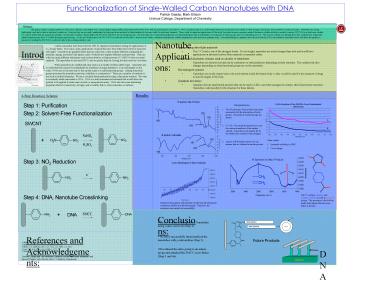Functionalization of SingleWalled Carbon Nanotubes with DNA - PowerPoint PPT Presentation
1 / 1
Title:
Functionalization of SingleWalled Carbon Nanotubes with DNA
Description:
... discovered in 1991 by Japanese researchers looking for applications of ... When nanotubes are synthesized, they arrive as a bundle of fibers called ropes. ... – PowerPoint PPT presentation
Number of Views:261
Avg rating:3.0/5.0
Title: Functionalization of SingleWalled Carbon Nanotubes with DNA
1
Functionalization of Single-Walled Carbon
Nanotubes with DNA Patrick Gasda, Mark
Ellison Ursinus College, Department of Chemistry
Nanotube Applications
Carbon nanotubes were discovered in 1991 by
Japanese researchers looking for applications of
C60 (bucky balls). Ever since, many applications
of nanotubes have been either discovered or
proposed (see right). Nanotubes are graphite
sheets that are rolled into a tube in three
different configurations armchair, zigzag, and
chiral (see figure), each of which have slightly
different conductivities. They are rolled up
using different techniques such as laser ablation
or high pressure CO (HiPCO) that use metal
catalysts. The nanotubes we use are HiPCO, and
we purify them by forcing hot and moist air over
them. When nanotubes are synthesized, they
arrive as a bundle of fibers called ropes.
Nanotubes are so small that they cannot be
manipulated by machines (average diameter is 2 nm
and lengths on the order of 500 nm) so the best
way to free up the ropes is to add functional
groups. Adding functional groups increases the
nanotube reactivity, solubility or conductivity.4
There are a number of methods to use such as
radical chemistry. We use a covalent
functionalization using a diazonium reaction. We
want to eventually attach nanotubes to DNA. DNA
is a well characterized molecule that would allow
the product to be applied to make nano circuits
or nanoparticle arrays. DNA also has some
interesting properties that let it selectively,
strongly, and reversibly link to other molecules
or surfaces.
- Super-strong/ultra-light materials
- The C-C bond is one of the strongest bonds. For
its weight, nanotubes are much stronger than
steel and would have applications in advanced
carbon fiber materials or nanotube cables. - Nano-sized electronic systems such as circuits or
transistors - Nanotubes are electron rich and can be conductors
or semiconductors depending on their structure.
The conductivity also changes depending on what
functional groups are on the nanotubes. - Bio-transport systems
- Nanotubes are mostly impervious to the
environment inside the human body so they would
be ideal for the transport of drugs to specific
targets in the body. - Quantum dot arrays
- Quantum dots are small metal particles that can
be used in LEDs, and when arranged in a lattice,
their fluorescence increases. Nanotubes could
possibly be the structure for these lattices.
Introduction
Results
4-Step Reaction Scheme
Interpretations
- The IR spectrum of the product has peaks
associated with the absorptions of nitro groups.
The peaks for amino groups are absent. - UV/Vis The small absorptions for A are the
various transitions of the surface orbitals.
Since this is not present for B, the surface has
somehow been changed. - Agrees with literature data so we can assume that
we obtained a similar product
- Other results
- Increased solubility in DMF
- Color change
SMCC contains aliphatic and aromatic carbons as
well as carbonyl groups. The spectrum to the
left has peaks that indicate that the
cross-linker is present.
Reduction data agrees with literature results and
all subsequent reductions resulted in a
flat-lined graph. Therefore, the reduction was
carried out successfully.
Conclusions
- We have successfully purified Nanotubes using
warm, moist air (Step 1). - We have successfully functionalized the
nanotubes with p-nitroaniline (Step 2). - We reduced the nitro group to an amino group and
attached the SMCC cross-linker (Step 3 and 4a).
References and Acknowledgements
1) Baker, S. E. et al. Nano Letters 2002, 2,
1413. 2) Bahr, J. L. et al. J. Am. Chem. Soc.
2001, 123, 6536. 3) Dyke, C. A. and Tour, J. M.
J. Am. Chem. Soc., 2003, 125, 1156. 4) Lee, C.-S.
et al. Nano Letters, 2004, 4, 1713. 5) White, C.
T. and Mintmire, J. W. J. Phys. Chem., 2005, 109,
52. Ursinus College and The American Chemical
Society Petroleum Research Fund Special Thanks
Steve Morris, the UC Chemistry Department































